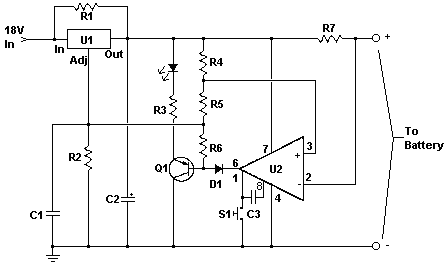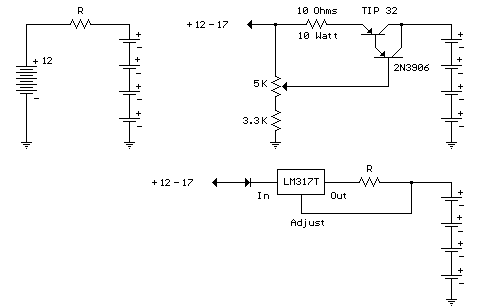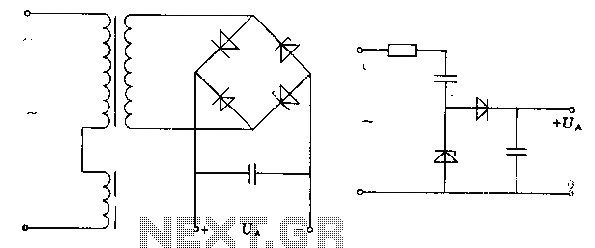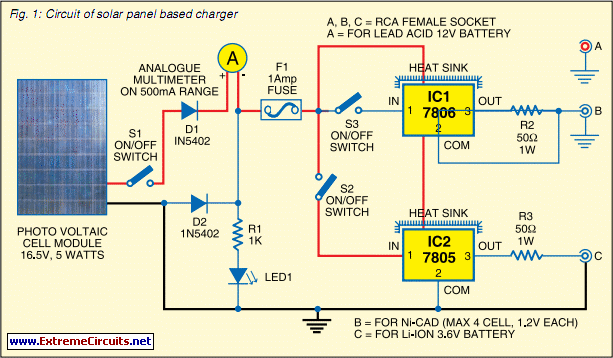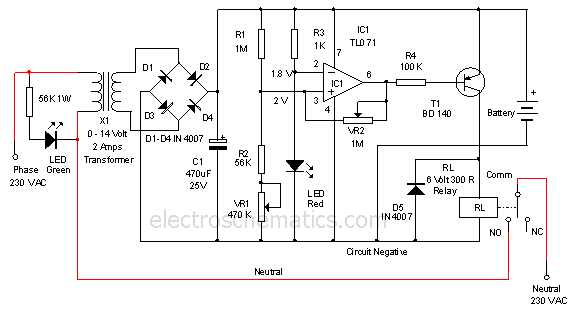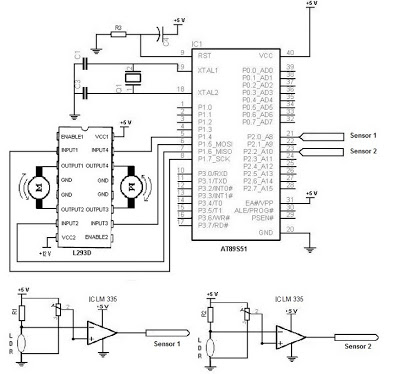
Solar Charger Schematic
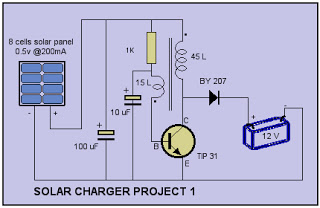
Utilizing sunlight as a power source can help reduce electricity costs. Below is a description of a simple power plant that can be created to charge a motorcycle battery or power emergency lights. Solar panels capture sunlight and convert it into electricity. However, the electricity generated from each panel is relatively low; for instance, an 8-cell panel arranged in series produces approximately 4 volts with a current of 200 mA. Therefore, an electronic circuit is required to boost the voltage and current to levels suitable for battery charging. This electronic circuit functions as a DC to DC inverter and consists of two capacitors, one resistor, one transistor, one diode, and a coil. The circuit employs a blocking oscillator system created by the transistor and coil, where the primary winding consists of 45 turns and the secondary winding has 15 turns, providing feedback to the base of the transistor. The output from the primary winding is connected to the diode, which facilitates battery charging. When coupled with emergency neon lights, this setup can provide sufficient voltage to illuminate the lights at night, utilizing energy stored in the battery charged during the day by sunlight.
The described circuit operates as a DC to DC inverter, designed to enhance the voltage and current output from solar panels for battery charging applications. The core components include a transistor that acts as a switch, controlling the flow of current through the primary winding of the coil. The primary winding, with 45 turns, generates a magnetic field that induces a voltage in the secondary winding of 15 turns. This induced voltage is critical for feedback to the transistor's base, ensuring stable oscillation and efficient operation.
Capacitors are employed to smooth out the voltage fluctuations and stabilize the output, while the resistor helps to limit the current flowing through the circuit, protecting sensitive components from potential damage. The diode serves a crucial role in directing the current towards the battery, preventing backflow and ensuring that the battery receives the correct polarity for charging.
The design is particularly advantageous for applications such as charging motorcycle batteries or powering emergency lighting systems. During the day, solar panels harness sunlight, converting it into electrical energy, which is then stored in the battery. At night, the stored energy can be utilized for lighting, providing a sustainable and cost-effective solution for energy needs.
This circuit exemplifies a practical approach to renewable energy utilization, demonstrating how simple electronic components can be integrated to create efficient energy systems that harness solar power. The design is both scalable and adaptable, allowing for modifications based on specific energy requirements or components available, thus promoting innovation in renewable energy applications.To take advantage of sunlight shining on the earth can continue to be utilized to serve as a power source so that we can at least save on electricity prices continuing to rise, below is one of a series of simple power plant can be created and used to fill your motorcycle battery or for emergency lights. Sunlight is received by the solar panels are then processed into electricity, but electricity generated from each panel is still too small where the 8 Cell Panel arranged in series only mrnghasilkan voltage of approximately 4 volts with a current 200 mA. nah therefore required an electronic circuit to increase the voltage and current enough to be used as a Battery Charger.
Electronic Rangakain act as a series of DC to DC Inverter (DC to DC Inverter), which was built by two pieces of Capacitor, Resistor 1, a transistor, a diode, and a coil which is the point of the creation of this series. The circuit was built with a single oscillator system (blocking oscillator) which was built by the transistor and a coil in which the primary winding totaling 45 turns and 15 turns in the secondary as feedback to provide the voltage at the base of the transistor output of the primary winding connected to the diode and used to The battery charging.
When the circuit is coupled with the Emergency Neon Lights will certainly get enough voltage to light at night for free. because its batteries during the day in charge by the sun. 🔗 External reference
The described circuit operates as a DC to DC inverter, designed to enhance the voltage and current output from solar panels for battery charging applications. The core components include a transistor that acts as a switch, controlling the flow of current through the primary winding of the coil. The primary winding, with 45 turns, generates a magnetic field that induces a voltage in the secondary winding of 15 turns. This induced voltage is critical for feedback to the transistor's base, ensuring stable oscillation and efficient operation.
Capacitors are employed to smooth out the voltage fluctuations and stabilize the output, while the resistor helps to limit the current flowing through the circuit, protecting sensitive components from potential damage. The diode serves a crucial role in directing the current towards the battery, preventing backflow and ensuring that the battery receives the correct polarity for charging.
The design is particularly advantageous for applications such as charging motorcycle batteries or powering emergency lighting systems. During the day, solar panels harness sunlight, converting it into electrical energy, which is then stored in the battery. At night, the stored energy can be utilized for lighting, providing a sustainable and cost-effective solution for energy needs.
This circuit exemplifies a practical approach to renewable energy utilization, demonstrating how simple electronic components can be integrated to create efficient energy systems that harness solar power. The design is both scalable and adaptable, allowing for modifications based on specific energy requirements or components available, thus promoting innovation in renewable energy applications.To take advantage of sunlight shining on the earth can continue to be utilized to serve as a power source so that we can at least save on electricity prices continuing to rise, below is one of a series of simple power plant can be created and used to fill your motorcycle battery or for emergency lights. Sunlight is received by the solar panels are then processed into electricity, but electricity generated from each panel is still too small where the 8 Cell Panel arranged in series only mrnghasilkan voltage of approximately 4 volts with a current 200 mA. nah therefore required an electronic circuit to increase the voltage and current enough to be used as a Battery Charger.
Electronic Rangakain act as a series of DC to DC Inverter (DC to DC Inverter), which was built by two pieces of Capacitor, Resistor 1, a transistor, a diode, and a coil which is the point of the creation of this series. The circuit was built with a single oscillator system (blocking oscillator) which was built by the transistor and a coil in which the primary winding totaling 45 turns and 15 turns in the secondary as feedback to provide the voltage at the base of the transistor output of the primary winding connected to the diode and used to The battery charging.
When the circuit is coupled with the Emergency Neon Lights will certainly get enough voltage to light at night for free. because its batteries during the day in charge by the sun. 🔗 External reference
